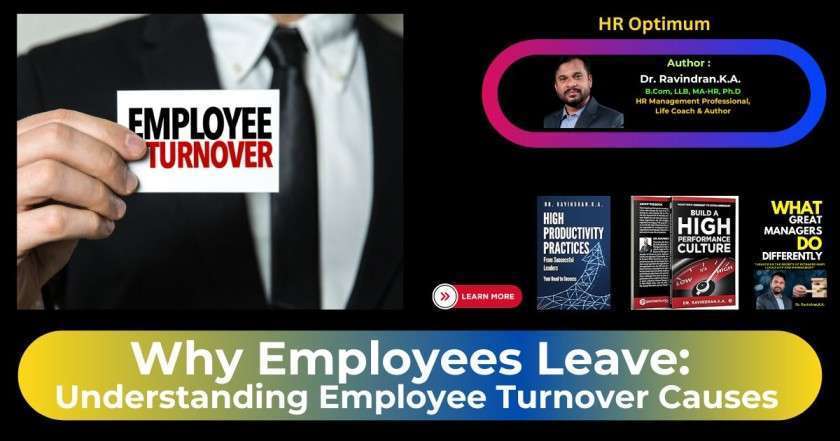Understanding Employee Turnover: What It Is and Why It Matters
Introduction
What is Employee Turnover?
Employee turnover refers to the rate at which employees leave an organization and are replaced by new employees. It is a crucial metric for businesses as it can significantly impact overall performance, productivity, and morale. Understanding the reasons behind turnover and finding ways to manage it effectively are essential for maintaining a stable and efficient workforce.
Thank you for reading this post, don't forget to subscribe!Importance of Understanding Employee Turnover
Employee turnover is more than just a statistic; it has far-reaching implications for any business. High turnover can lead to increased costs, decreased productivity, and a negative impact on company culture. Conversely, low turnover can indicate a healthy work environment, employee satisfaction, and effective management practices. Therefore, understanding and managing turnover is vital for any organization’s success.
Types of Employee Turnover
Voluntary vs. Involuntary Turnover
Voluntary turnover occurs when employees choose to leave the organization, often for reasons such as better job opportunities, personal reasons, or dissatisfaction with their current role. On the other hand, involuntary turnover happens when employees are terminated due to performance issues, layoffs, or organizational restructuring.
Key Differences:
- Voluntary Turnover: Initiated by the employee, often predictable.
- Involuntary Turnover: Initiated by the employer, often unexpected.
Functional vs. Dysfunctional Turnover
Functional turnover occurs when low-performing employees leave the organization, which can be beneficial as it opens up opportunities for hiring better talent. Dysfunctional turnover, however, happens when high-performing employees leave, which can be harmful to the organization.
Measuring Employee Turnover
Turnover Rate Calculation
Calculating the employee turnover rate helps organizations understand the extent of their turnover problem. The basic formula is:
Turnover Rate = (Number of separations / Average number of employees)
For example, if a company has 10 separations and an average of 100 employees over a year, the turnover rate would be 10%.
Benchmarking Turnover Rates
Comparing your turnover rates with industry benchmarks can provide valuable insights. For instance, the retail industry often has higher turnover rates compared to the tech industry. Knowing where your company stands can help identify if your turnover rate is a cause for concern.
Causes of Employee Turnover
Common Reasons for Voluntary Turnover
- Job Dissatisfaction: Employees may leave if they are unhappy with their job roles, work environment, or management.
- Better Opportunities: Many employees leave for higher pay, better benefits, or career advancement opportunities elsewhere.
- Work-Life Balance: Employees may seek positions that offer a better balance between work and personal life.
Factors Contributing to Involuntary Turnover
- Performance Issues: Employees who consistently underperform may be let go.
- Organizational Restructuring: Layoffs due to mergers, acquisitions, or downsizing can lead to involuntary turnover.
Impact of Employee Turnover
Financial Costs
Employee turnover can be costly. It includes direct costs like recruitment, training, and severance pay, and indirect costs such as lost productivity and decreased morale. According to the Society for Human Resource Management (SHRM), the average cost to replace an employee is six to nine months of their salary.
Effects on Team Morale and Productivity
High turnover can disrupt team dynamics, leading to decreased productivity and morale. Remaining employees may feel overworked and stressed, which can further increase turnover rates.
Customer Satisfaction and Company Reputation
Frequent turnover can affect customer satisfaction, especially in customer-facing roles. Customers value consistency and may feel less confident in a company that frequently changes staff. Additionally, a high turnover rate can harm a company’s reputation, making it harder to attract top talent.
Strategies to Reduce Employee Turnover
Improving Employee Engagement
Engaged employees are less likely to leave. Here are some ways to boost engagement:
- Regular Feedback and Recognition: Acknowledge employee contributions and provide constructive feedback.
- Career Development Opportunities: Offer training and career advancement opportunities.
Offering Competitive Compensation and Benefits
Competitive pay and benefits are crucial in retaining employees. Conduct regular market analysis to ensure your compensation packages are attractive.
Providing Career Development Opportunities
Employees value growth and development. Offer training programs, mentorship, and clear career paths to keep them motivated and engaged.
Enhancing Work Environment and Culture
A positive work environment fosters loyalty. Promote a culture of respect, inclusion, and collaboration. Flexible work arrangements can also enhance work-life balance, reducing turnover.
Monitoring and Analyzing Turnover Trends
Regular Turnover Analysis
Regularly analyze turnover data to identify patterns and areas for improvement. Use metrics such as turnover rate by department, role, and tenure.
Using Employee Feedback
Leverage exit interviews and employee surveys to gather insights into why employees are leaving and what can be improved.
Implementing Continuous Improvement Plans
Use the data collected to implement continuous improvement plans. Adjust strategies as needed based on feedback and performance metrics.
Case Studies and Examples
Companies with Low Turnover Rates
Google: Known for its excellent employee benefits, flexible work environment, and opportunities for growth, Google maintains a low turnover rate.
Southwest Airlines: Their focus on a strong company culture and employee satisfaction has resulted in low turnover rates and high employee loyalty.
Lessons Learned from High Turnover Cases
Amazon: Known for its high turnover rates in some departments, Amazon has faced criticism for its demanding work environment. Lessons include the importance of work-life balance and employee well-being.
Conclusion
Recap of Key Points
Understanding employee turnover is essential for any organization. It impacts financial performance, team morale, and overall productivity. By identifying the causes and implementing effective strategies, companies can reduce turnover and create a more stable and satisfied workforce.
Final Thoughts
Proactively managing employee turnover requires continuous effort and commitment. By fostering a positive work environment, offering competitive compensation, and providing growth opportunities, organizations can retain their best talent and ensure long-term success.
Thank You!
Thank you for reading this article! If you found it helpful, please share it with your colleagues and friends. We value your feedback, so feel free to leave a comment below and let us know your thoughts.
FAQs
Q1: What is employee turnover? Employee turnover refers to the rate at which employees leave an organization and are replaced by new hires.
Q2: How is employee turnover rate calculated? The turnover rate is calculated by dividing the number of separations by the average number of employees, then multiplying by 100.
Q3: Why is high employee turnover a problem? High turnover can lead to increased costs, decreased productivity, and negative impacts on team morale and company reputation.
Q4: What are some common causes of employee turnover? Common causes include job dissatisfaction, better job opportunities, performance issues, and organizational restructuring.
Q5: How can companies reduce employee turnover? Companies can reduce turnover by improving employee engagement, offering competitive compensation, providing career development opportunities, and fostering a positive work environment.
 hroptimum
hroptimum




